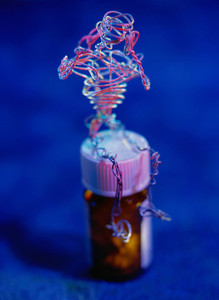Could a combination of three blood-pressure-lowering drugs at low doses, with a statin, aspirin, and folic acid in one pill (the polypill), reduce cardiovascular events by more than 80% in healthy individuals? This was examined in a study funded by Cadila Pharmaceuticals in Ahmedabad, India (that wants to market the polypill as the ‘Polycap’), in which the effect of such a pill was assessed on blood pressure, lipids, heart rate, and urinary thromboxane B2, as well as its tolerability.
Generic polypill could reduce heart disease
Generics/General
|
Posted 02/12/2009
 0
Post your comment
0
Post your comment

India, in which 2053 individuals without cardiovascular disease, aged 45–80 years, and with one risk factor were randomly assigned, by a central secure website, to the Polycap (n = 412) consisting of low doses of thiazide (12.5 mg), atenolol (50 mg), ramipril (5 mg), simvastatin (20 mg), and aspirin (100 mg) per day, or to eight other groups, each with about 200 individuals, of aspirin alone, simvastatin alone, hydrochlorthiazide alone, three combinations of the two blood-pressure-lowering drugs, three blood-pressure-lowering drugs alone, or three blood-pressure-lowering drugs plus aspirin. The primary outcomes were LDL for the effect of lipids, blood pressure for antihypertensive drugs, heart rate for the effects of atenolol, urinary 11-dehydrothromboxane B2 for the antiplatelet effects of aspirin, and rates of discontinuation of drugs for safety. Analysis was by intention to treat. (This study is registered with ClinicalTrials.gov, number NCT00443794).
The findings were that compared with groups not receiving blood-pressure-lowering drugs, the Polycap reduced systolic blood pressure by 7.4 mm Hg (95% CI 6.1–8.1) and diastolic blood pressure by 5.6 mm Hg (4.7–6.4), which was similar when three blood-pressure-lowering drugs were used, with or without aspirin. Reductions in blood pressure increased with the number of drugs used (2.2/1.3 mm Hg with one drug, 4.7/3.6 mm Hg with two drugs, and 6.3/4.5 mm Hg with three drugs). Polycap reduced LDL cholesterol by 0.70 mmol/L (95% CI 0.62–0.78), which was less than that with simvastatin alone (0.83 mmol/L, 0.72–0.93; p = 0.04); both reductions were greater than for groups without simvastatin (p<0.0001). The reductions in heart rate with Polycap and other groups using atenolol were similar (7.0 beats per minute), and both were significantly greater than that in groups without atenolol (p<0.0001). The reductions in 11-dehydrothromboxane B2 were similar with the Polycap (283.1 ng/mmol creatinine, 95% CI 229.1–337.0) compared with the three blood-pressure-lowering drugs plus aspirin (350.0 ng/mmol creatinine, 294.6–404.0), and aspirin alone (348.8 ng/mmol creatinine, 277.6–419.9) compared with groups without aspirin. Tolerability of the Polycap was similar to that of other treatments, with no evidence of increasing intolerability with increasing number of active components in one pill.
The interpretation of TIPS was that this Polycap formulation could be conveniently used to reduce multiple risk factors and cardiovascular risk.
TIPS comment
As commented by Mr Christopher Cannon in The Lancet [2], the concept of the polypill is simple. Several different drugs are available generically (and thus inexpensively) to treat many of the cardiac risk factors. So, combining three (generic) blood-pressure-lowering drugs at low doses with a (generic) statin, (generic) aspirin, and (generic) folic acid into one polypill may reduce cardiovascular events by more than 80% in healthy individuals, he writes.
According to him, this approach has obvious appeal, and vast implications for global health, because heart disease is the leading cause of death worldwide. “The Indian Polycap Study (TIPS) moves us one step closer to realising this dream,” Mr Cannon states.
He explains that TIPS was a large phase II randomised trial that assessed the effects of nine different pills containing either single agents or combinations of two, three, four, or five (the polypill) drugs, to measure their effect on risk factors such as blood pressure and cholesterol concentrations, as well as the feasibility and tolerability of administering a single pill to a relatively unselected group of patients. The study was not a large outcomes trial to show that the polypill reduced mortality, Mr Cannon stresses.
“So the group of patients studied was one that has been increasing rapidly in numbers in the past decade with the increase in obesity across the world – middle-aged (45–80 years) men and women without previous cardiac disease, but with at least one cardiovascular risk factor: high blood pressure, obesity (measured by the hip to waist ratio, high cholesterol, diabetes, or smoking),” Mr Cannon explains.
According to Mr Cannon, the results from TIPS show that each of the components of the polypill did what was intended: the statin reduced cholesterol, the three antihypertensives reduced blood pressure – and the more of them, the greater the reduction – and aspirin reduced the clotting ability of the blood.
They found one unexpected issue with the Polycap: the degree of cholesterol lowering was slightly less with the Polycap than in patients who got simvastatin alone. “This effect seems to be related to the rate of conversion of simvastatin in the Polycap. This finding highlights the importance of a phase II study such as TIPS to identify any such issues with the polypill, before testing in a large outcomes trial. Also, in view of the safety and tolerability in large trials of simvastatin 40 mg, the next generation polypill might shift to that higher dose (or to a moderate dose of a more potent statin which should become available generically in a few years),” he writes.
Mr Cannon stresses that a key and very promising finding from TIPS was the tolerability of the Polycap. “Although the rates of discontinuation were higher than one might have anticipated in a 12-week study (about 15%), much of it was apparently due to social reasons and patients refusing treatment. There was, however, not a significantly higher rate overall of discontinuation with the Polycap compared with the other combinations. Some regimens seemed to be a little better tolerated, and those with triple antihypertensives had a slightly higher rate of hypotension (as would be expected). On the other hand, some components of the polypill might help counteract side effects of others, e.g. potassium concentrations for the angiotensin-converting-enzyme inhibitor and the diuretic. Fortunately the absolute rate of drug-specific discontinuations was low, which means that the overall feasibility and tolerability of the polypill approach does seem to work. It was also found that one can treat patients with multiple classes of drugs for cardiovascular risk factors, even if the patients do not have some of these risk factors”.
Polypill challenges
According to Mr Cannon, a challenge for the future is to establish a large phase III trial with longer follow-up to assess the true feasibility of this strategy. “How can the use of a polypill be implemented in a broad population? What is the full safety profile (there were 3–8% of patients who had increases in creatinine and potassium and in liver function tests; what adjustments need to be made to those patients?)? Do they stop the polypill if one component causes a side effect? How does the doctor decide which component caused the side effect? Second[ly], it would be good to have a large outcomes trial, to document a reduction in death, myocardial infarction, and stroke with the polypill approach compared with current practice. Third[ly], there is the issue of dose, which is a fascinating difference from current practice. The Polycap had just one dose (generally a moderate dose) of each agent. Currently for combination pills, regulatory authorities require that the pill be available in every dose combination of each drug, so the combination pill would not limit treatment. However, this approach would obviously not be feasible with a pill with five or six components and each having two to four doses (which would lead to more than a hundred strengths of the polypill). Thus what is designed to be a simple pill would turn into a complicated prescribing morass. It might be feasible to consider having two or three broad strengths with some different doses of some components, e.g. the antihypertensives or there could be versions with only some components of the polypill that would, for example, have fewer anti-hypertensive drugs. That approach might help when treating a patient with only single risk factors, e.g. a smoker without high blood pressure. Should such a patient be put on three antihypertensives, and thus have the risk of angio-oedema, glucose intolerance, or bradycardia?” he argues.
As a final challenge he mentions, “Would the availability of a single magic bullet for the prevention of heart disease lead people to abandon exercise and appropriate diet? Would this make two of the major root causes of heart disease worse? Hopefully not, but the medical profession would need to help ensure that this would not happen.”
In his comment, Mr Cannon also asks where this polypill would fit into current medical practice. “The major appeal is its simplicity and (presumed) low cost, which could improve compliance. Such appeal could have broad applicability in areas of the world with less access to medical treatment, where just one or two interactions with medical professionals could be the start of treatment that could lead to long-term cardiovascular prevention. But the polypill could also fit well into more modern medical systems, in which large proportions of patients with risk factors are untreated. If all these patients knew they could simply take their polypill, they might be more receptive to it – and as such vastly broaden the number of patients who might benefit from drugs that had been proven in multiple trials to reduce cardiovascular disease and mortality. Although TIPS does not provide all the answers, the study does take a first and crucial step forward and raises hope that, in conjunction with other global efforts to improve diet and exercise, the polypill could one day substantially reduce the burden of cardiovascular disease in the world,” he concludes.
TIPS correspondence
Mr Nicholas Wald and Mr Malcolm Law of the Wolfson Institute of Preventive Medicine at Barts and The London School of Medicine and Dentistry, Queen Mary University of London, UK (the ‘inventors’ of the Polypill, as detailed in their 2000 patent application and in BMJ. 2003;326:1419-23), comment in The Lancet [3] that “the TIPS results are welcome in showing that a polypill can be produced and used in healthy people in a practical manner”. Previously, they had shown themselves that absolute and proportional blood pressure changes and absolute cholesterol changes vary with pre-treatment level but that proportional cholesterol changes do not. They comment that the cholesterol and blood pressure reductions in TIPS were smaller than their 2003 estimates, but they believe that their own estimates were correct and that the TIPS results underestimate the health benefits of a polypill.
Mr Robert Safford of the Division of Cardiovascular Diseases, the Mayo Clinic at Jacksonville, Florida, USA, comments in the same article that a third of the TIPS participants were diabetic – a population in which clustering of risk factors is known to be common – and that perhaps this initial investigation of the Polycap was not limited to average-risk people. Furthermore, he states that the polypill miracle cannot occur without a major improvement in patients’ adherence. “No adherence data were provided in either the TIPS paper or the accompanying Comment. If most patients prescribed a single agent miss doses and then quit early, what differences can one expect of a polypill formulation of multiple drugs? It is one pill per day in either case,” he writes. It indeed remains to be seen whether a generic polypill would be taken preventatively in practice.
‘Polymeal’ works too
According to Westerweel, Verhaar and Van Wijk in the Dutch medical magazine Nederlands Tijdschrift voor Geneeskunde [4], the polypill is not an effective strategy against cardiovascular diseases. They state that for low-risk patients – such as seemingly healthy 55+ people – the lowering of cardiovascular morbidity does not outweigh bleeding complications. Furthermore, individuals would be either over- or undertreated without any monitoring. For people above 55 years, the cardiac risk is only 1% a year, which would be reduced to 0.8% a year with an effective polypill. With such a small risk reduction of 0.2%, only 20% of the people are prepared to take a preventative medication. Furthermore, therapy adherence is bad in such a case. One should take the polypill for the rest of his life, but after a year at most 50% of the people will still take such a preventative pill. The authors argue that another disadvantage of the polypill might be accompanying synergistic side effects of its active ingredients, though this was not observed in TIPS. Westerweel et al. state that the best way to reduce cardiac risk is life-style improvement with a ‘polymeal’, consisting of a diet of fish, chocolate, vegetables, fruit, garlic, almonds and red wine, for which about the same effect was predicted as for the polypill [5]. According to the authors, this would be “a more natural, safer, and probably tastier (than the Polypill) strategy to reduce cardiovascular disease by more than 75%”.
Yet research studies into the promise of the polypill are ongoing. In a study by Franco et al. [6] it was concluded that – though several polypill formulations have been developed and a recent trial demonstrated the short-term feasibility, safety and efficacy (in reducing risk factor levels) of a polypill in individuals at moderate risk – many challenges remain and studies are underway. These will address questions related to formulation of polypill(s), the long-term safety and tolerability, the efficacy in reducing risk factor levels and cardiovascular events, physician, patient and societal acceptability, adherence, regulatory requirements, cost and impact on lifestyle habits.
References:
- Yusuf S, Pais P, Afzal R, Xavier D, Teo K, Eikelboom J, Sigamani A, Mohan V, Gupta R, Thomas N, et al. Effects of a polypill (Polycap) on risk factors in middle-aged individuals without cardiovascular disease (TIPS): a phase II, double-blind, randomised trial. The Lancet. 2009 April 18;373(9672):1341-51. Published online 2009 Mar 30.
- Christopher P Cannon. Can the polypill save the world from heart disease? The Lancet. 2009 April 18;373(9692):1313-4. Published online 2009 Mar 30.
- Nicholas Wald, Malcolm Law, Robert E Safford. The Indian Polycap Study (TIPS). The Lancet. 2009 September 5;374(9692):781.
- Westerweel PE, Verhaar MC, van Wijk JPH. Nederlands Tijdschrift voor Geneeskunde. 2005;149:1741.
- Oscar H Franco, Luc Bonneux, Chris de Laet, Anna Peeters, Ewout W. Steyerberg and Johan P. Mackenbach. The limits of medicine – The Polymeal: a more natural, safer, and probably tastier (than the Polypill) strategy to reduce cardiovascular disease by more than 75%. BMJ. 2004;329:1447-50.
- Lonn E, Yusuf S. Polypill: the evidence and the promise. Curr Opin Lipidol. 2009 Oct 30. [Epub ahead of print].
Source: The Lancet; Nederlands Tijdschrift voor Geneeskunde; BMJ; Current Opinion in Lipidology
Research
Japan’s drug shortage crisis: challenges and policy solutions
Saudi FDA drug approvals and GMP inspections: trend analysis
EMA launches European shortages monitoring platform to tackle persistent medicine shortages

Generics/General Posted 03/12/2024
FDA releases one-year progress report for the Generic Drug Cluster

Generics/General Posted 28/10/2022
The best selling biotechnology drugs of 2008: the next biosimilars targets








Post your comment